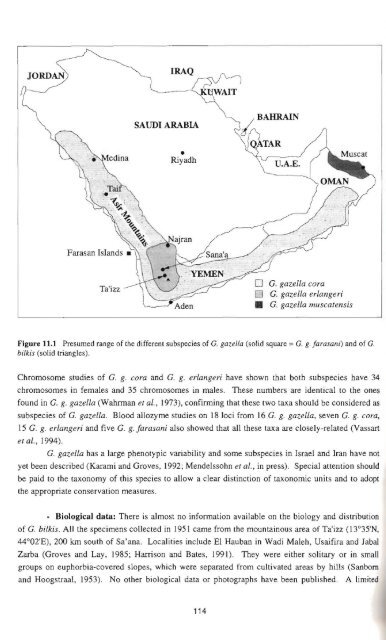CONSERVATION OF ARABIAN GAZELLES - Nwrc.gov.sa
CONSERVATION OF ARABIAN GAZELLES - Nwrc.gov.sa
CONSERVATION OF ARABIAN GAZELLES - Nwrc.gov.sa
Create successful ePaper yourself
Turn your PDF publications into a flip-book with our unique Google optimized e-Paper software.
SAUDI ARABIA<br />
BAHRAIN<br />
•<br />
Riyadh<br />
V.A.E.<br />
Fara<strong>sa</strong>n Islands<br />
Ta'izz<br />
YEMEN<br />
G. gazella cora<br />
o G. gazella erlangeri<br />
Aden • G. gazella muscatensis<br />
Figure 11.1 Presumed range of the different subspecies of G. gazella (solid square ~ G. g. Jara<strong>sa</strong>"i) and of G.<br />
bilkis (solid triangles).<br />
Chromosome studies of G. g. cora and G. g. erlangeri have shown that both subspecies have 34<br />
chromosomes in females and 35 chromosomes in males. These numbers are identical to the ones<br />
found in G. g. gazella (Wahrman et aI. , 1973), confirming that these two taxa should be considered as<br />
subspecies of G. gazella. Blood allozyme srudies on 18 loci from 16 C. g. gazella , seven C. g. cora,<br />
15 C. g. erlangeri and five C. g. fara<strong>sa</strong>ni also showed that all these taxa are closely-related (Vas<strong>sa</strong>rt<br />
et al., 1994) .<br />
C. gazella has a large phenotypic variability and some subspecies in Israel and Iran have not<br />
yet been described (Karami and Groves, 1992; Mendelssohn et al., in press). Special attention should<br />
be paid to the taxonomy of this species to allow a clear di stinction of taxonomic units and to adopt<br />
the appropriate conservation measures.<br />
- Biological data: There is almost no information available on the biology and distribution<br />
of C. bilkis. All the specimens collected in 1951 came from the mountainous area of Ta'izz (13°35'N,<br />
44°02'E), 200 km south of Sa'ana. Localities include EI Hauban in Wadi Maleh, U<strong>sa</strong>ifira and Jabal<br />
Zarba (Groves and Lay. 1985; Harrison and Bates, 1991). They were either solitary or in small<br />
groups on euphorbia-covered slopes, which were separated from cultivated areas by hills (Sanborn<br />
and Hoogstraal, 1953). No other biological data or photographs have been published. A limited<br />
114
















